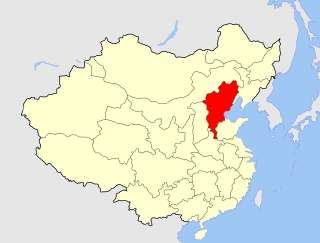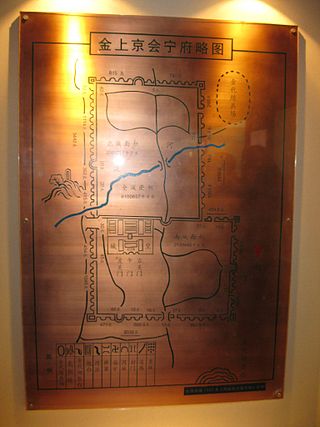
Jiankang, or Jianye, as it was originally called, was the capital city of the Eastern Wu, the Eastern Jin dynasty and the Southern Dynasties (420–552), including the Chen dynasty. Its walls are extant as ruins in the modern municipal region of Nanjing. Jiankang was an important city of the Song dynasty. Its name was changed to Nanjing during the Ming dynasty.
This is a list of historical capitals of China.

Kaifeng is a prefecture-level city in east-central Henan province, China. It is one of the Eight Ancient Capitals of China, having been the capital eight times in history, and is most known for having been the Chinese capital during the Northern Song dynasty.

Púxiān Wànnú was a Jurchen warlord who established the short-lived Eastern Xia dynasty in 13th-century China.

Zhili, alternately romanized as Chihli, was a northern administrative region of China since the 14th century that lasted through the Ming dynasty and Qing dynasty until 1911, when the region was dissolved, converted to a province, and renamed Hebei in 1928.

Manchuria is a region in East Asia. Depending on the definition of its extent, Manchuria can refer either to a region falling entirely within present-day China, or to a larger region today divided between Northeast China and the Russian Far East. To differentiate between the two parts following the latter definition, the Russian part is also known as Outer Manchuria, while the Chinese part is known as Northeast China.
Nanjing means "southern capital" and is the name of the current capital of Jiangsu Province and a former capital of China.

You Prefecture or YouProvince, also known by its Chinese name Youzhou, was a prefecture (zhou) in northern China during its imperial era.
The city of Beijing has a long and rich history that dates back over 3,000 years.

Huining Fu, or Shangjing Huiningfu, was a Fu in the Shangjing region of Northeast China. It served as the first superior capital of the Jurchen-led Jin dynasty (1115-1234) from 1122 to 1153. Its location was in present-day Acheng District, Harbin, Heilongjiang Province.
京 is the Han character meaning "capital (city)," and the simplified form of the older way of writing the character, 亰. The character is predominantly used in the names of current and former capital cities within the East Asian cultural sphere.
The Eastern Xia, also known as Dongxia, Dongzhen (東真) or Dazhen (大真), was a short-lived kingdom established in Manchuria by the Jurchen warlord Puxian Wannu in 1215 during the Mongol conquest of the Jin dynasty. It was eventually conquered by the Mongols and its former territories were later administered by the Liaoyang province of the Yuan dynasty.

Lower Yangtze Mandarin is one of the most divergent and least mutually-intelligible of the Mandarin languages, as it neighbours the Wu, Hui, and Gan groups of Sinitic languages. It is also known as Jiang–Huai Mandarin, named after the Yangtze (Jiang) and Huai Rivers. Lower Yangtze is distinguished from most other Mandarin varieties by the retention of a final glottal stop in words that ended in a stop consonant in Middle Chinese.

"Beijing" is from pinyin Běijīng, which is romanized from 北京, the Chinese name for this city. The pinyin system of transliteration was approved by the Chinese government in 1958, but little used until 1979. It was gradually adopted by various news organizations, governments, and international agencies over the next decade.
Shangjing or 上京 may refer to:

Taiye Lake or Taiye Pond was an artificial lake in imperial City, Beijing, during the Jin, Yuan, Ming, and Qing dynasties of China. The beauty and utility of the lake was responsible for the siting of Kublai Khan's palace and the position of modern Beijing. It continues to exist but it is now known separately as the North, Central, and South Seas, the three interconnected lakes just west of the Forbidden City in downtown Beijing. The northern lake makes up the public Beihai Park while the southern two are grouped together as Zhongnanhai, the headquarters for the Communist leadership of the People's Republic of China.

Nanjing was the name for modern Beijing during the Khitan-led Liao dynasty of China, during which it served as the empire's southern capital. To distinguish "Nanjing" from the modern city of Nanjing in Jiangsu, and Beijing Damingfu, the name for modern Daming County in Hebei Province during the Northern Song dynasty, Chinese historians sometimes refer to Liao-era Beijing as Liao Nanjing. The Liao acquired the city, then known as Youzhou, in the cession of the Sixteen Prefectures in 938 by the Later Jin, one of the five short-lived dynasties that ruled northern China following the end of the Tang dynasty. The city was officially renamed "Nanjing, Youdu Fu" (南京幽都府). In 1012, the city was renamed "Nanjing, Xijin Fu" (南京析津府). The city was also colloquially referred to at the time as "Yanjing". In 1122, the city was captured by the Jurchen-led Jin dynasty (1115–1234)—who officially renamed it "Yanjing", ending the use of "Nanjing" for what is today modern Beijing.

The Liao dynasty was a Khitan-led dynasty of China that ruled over parts of Northern China, Manchuria, the Mongolian Plateau, northern Korean Peninsula, and what is modern-day Russian Far East from 916 until 1125 when it was conquered by the Jin dynasty. Remnants of the Liao court fled westward and created the Western Liao dynasty which in turn was annexed by the Mongol Empire in 1218.

Linhuangfu was the primary capital city of the Liao dynasty of China, during which it was also known as Shangjing. The city was founded in 918 by the Liao emperor Yelü Abaoji, and was named Shangjing Linhuangfu in 938. Its ruins are located in present-day Baarin Left Banner in Chifeng, Inner Mongolia, China.












